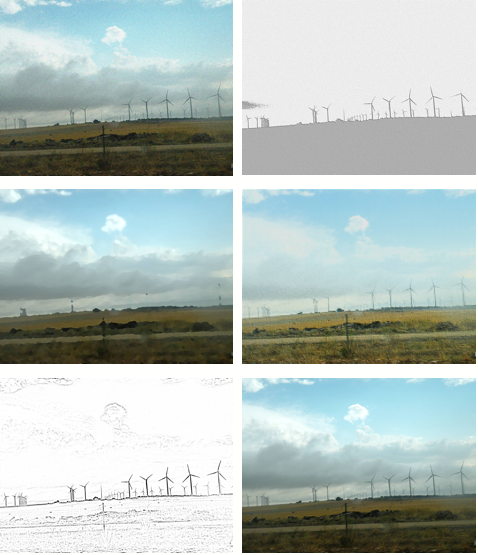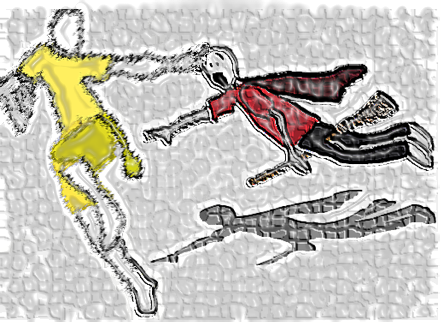Below, I took two photos (of my own taking while I was in Spain) and used the majority of MicrosoftWord’s 51 set effects–the name of the effects include glass, mosaic, copier, smudge– to alter them. I would recommend zooming in to see the photos better.






READING: DuChamp remix project
At first, I found the video’s interactive controls anti-intuitive. They were too complicated. There were too many of them, and they flustered me. My roommate had a similar yet drastically different response. Playing around with the video before going to dinner, he stated his confusion, “What do you expect. It’s DuChamp.” Which brings me to my point– he had a response I never would have had. Although we were both undergoing similar emotions (confusion), his previous experiences allowed him a different, if not also greater, understanding of the material. He recognized that the video, which is highly abstract in nature, is actually based on an equally abstract artist. Taking this into consideration, I began to enjoy playing around with the video’s controls more. I simplified the settings by deleting all but one of the orbiting circles and then learned all of the mini-controls associated with that circle. By doing so, I learned the functionality of each button, even if I still did not understand the overall purpose of the video’s interactions.

(The first four images that come up for DuChamp on Google, then digitally altered).
I turned the video’s lyrics back on, after turning them off during the simplification process, and came to the conclusion that you can choose to pay attention to the lyrics or, conversely, ignore them, even turn them off as I had done. What you cannot do, however, is alter the opening’s appearance and the resulting impression you make. No matter how you go about changing the settings, the opening setup is always the same. DuChamp’s speech about art and intuition makes you wonder: what the heck is the point of this thing? What am I supposed to be getting out of it? And then you come up with your answers, even if they end up being as abstract as the original artwork itself.
READING: StudyParty
(I think I responded to the wrong article. The links on our blog did not take me to the exact reading on ERES, but instead to excerpts then followed by the reading. This response is on one of the excerpts).
This is a response to Paul D. Miller aka DJ Spooky That Subliminal Kid. In the first excerpt, the author discusses how skype connected him and his wife when he was in Geneva and she was at home. They were able to listen to separate music and be in different locations, and yet share an electronic setting. Craziness. Well, I’m taking it a step further. Put on some music and click on the link below and you’ll get to engage in that most engaging of experiences. You’ll get to study with Joshua S. Aichenbaum for 20 seconds. Don’t ask questions or try to engage him in conversation. Don’t think too hard about what music he must be listening to either. Because then, before you know it, the time will be gone and you won’t get any work done.
(I wasn’t listening to any music anyway).
READING: You vote, you (buy) decide
This is a response to Ross’ Chapter 2 in Beyond the Box. In the chapter there is a section entitled “You vote, you decide: American Idol and Choice,” which questions whether tele-interactivity empowers its viewer or gives even more power to (cue scary music) The INDUSTRY (add lightning flashing). I. myself, have no opinion and do not endorse the idea that viewer participation is solely for the sake of advertising one product or another (that may or may not be refreshingly delicious and made from fresh apples). You, on the on the other hand, have an opinion and can vote for “yes, I love viewer participation even if it is working hand in hand with corporate bla-bla” by clicking on the left image. Click on the right and you will be be voting, “No, I do not support viewer participation aiding commercialism.”
Woodchuck’s will one day be this blog’s sponsor.
READING: A Personal Self(Blog)-Assessment
I just finished reading Rettberg’s first two chapters of Blogging and I’ve realized it’s time to assess what I’ve done here, so far, and where I belong in the blogosphere. Rettberg poses that blogs have genres, and therefore I would suppose that my blog would also fit within a set genre. In some ways, my blog is very personal, using the personal I and being very much about I and my projects and thoughts, thus emulating Rettberg’s example of a personal diary blog: dooce.com, but my blog also attempts filterblogging. On one or two occasions, I’ve linked a video I enjoyed or thought was vaguely interconnected to our course’s studies. So, if we had to define this blog, what terms would we use? Have I exemplified a mind-boggling re-rendering of genre, combining the personal genre with an external filtering one or…? No, clearly not. I would say that up to this point this blog has been a place to respond to our readings and I am only slowly becoming more comfortable with the medium, experimenting and incorporating visuals… 
and recognizing that a blog is an interactive medium (if you’re wondering about the image chosen above, I got an e-mail from QuidClub yesterday asking for logos for a Quidditch shirt and I was bored last night, so call it fan-fiction or whatever you like, but I fixed this together using the technological wonders of MicrosoftWord. We’ll see if the club chooses it. I’ve been told it’s too intricate of a design). But anyway, all this reminds me a blog is about interactivity!!! It’s a dialogue and not a one-way street, so post a reply if you have one. Riddle my drawings, riddle my timbers, criticize and riddle whatever you’d like, but let’s get Platonic and start up a dialogue!
FUN VIDEO
wildly-popular-iron-man-trailer-to-be-adapted-into,14226
I’m reading Jonathon Gray’s book for Storytelling and he mentions this video (which I had seen before). It’s relevant to how fans enter a viewing experience with preconceived expectations based on outside texts (Gray refers to them as paratexts).
READING: They’re letting you write a blog-post about that?
Call me a time-traveling skeptic. Call me whatever you want (Joshie-Woshie might be stretching it). But I found reading this primary document from 1998 was difficult without being cynical and realizing that from a modern perspective it is really not that amazing someone would let you write your thesis on Xena (my crazy Film professor is letting me write a transmedia experimental script as my final project). Film and Media Studies has become fairly common-place in American universities. Although still burgeoning, the department is gaining respect as an academic, analytic lens for viewing the world. And why? I would say the increase in diverse means of communication and the complexities of modern media consumption are highly responsible. That is what Rowett is really trying to point out. She is using her vantage point from the beginning of a trend to note a dynamic, stomach-like digestive relationship between fan and creator. Fans may not feed creators their ideas, but they certainly provide a reaction and an after-effect. Which leads me to a meta-self-reflexive question? Am I a fan, in an objective sense, of Rowett’s article? Am I providing a digestive feedback to her 10-year old article and building upon its history? And in ten years will some little schmuck be writing an article entitled, “They’re letting you write your senior thesis tweat about that? Probably. He probably will.
READING: Have I ever been a cult fan?
In reading Felschow’s article, I asked myself whether I am or have ever been a cult fan. Although an avid watcher of a variety of shows over the years, the closest example I could think of was my deep affiliation with The Simpsons. Since I approached double-digits I have consumed The Simpsons’ episodes and made a point to collect The Simpsons’ merchandise, ranging from buying books about the show or talking action figures (this practice waned as I got older) and playing a variety of the show’s videogames. But could I categorize myself as a cult fan due to my dutiful consumptive practices? I don’t think so. I certainly have felt the otherness Felschow describes. Somewhere approaching my teens, I hid my vast Simpson’s knowledge and my figurines in my basement, so I would not come off as being weird to my friends. Nevertheless, outside the occasional daydream of wanting to write for the long-living show, I have never imagined myself capable of exerting an influence over the show’s material. Perhaps, that is due to the fact the show is not serial-based and is more episodic. But, more importantly, I think it is because my viewing mindset does not permit me be part of Jenkin’s “resistant and creative audience” (4.2). I have never created fan-fiction or fan-art or participated in online forums because my viewing practices are very much personal. They are more so about my direct interaction with the show’s set, scripted world and less so about altering the world to my liking.
READING: Ross Introduction and Chapter 1
In Ross’ introduction he brings up to idea of audience invitation. That is to say there are different modes of inviting audience members to participate with a story, be it for television or within traditional oral history, and this means of invitation affects audience self-conception and activity. I would like to use this space to ponder how my final project could invite its reader to participate.
As a screenplay, my project would create a readerly, critical relationship. The relationship would be writer to reader, and the only resulting interaction would be editorial, having the reader provide feedback in a traditional means. Another possibility would be to write a screenplay and to have in its diegesis a blog that the protagonist uses. I could then set up a blog paralleling this diegetic one and invite my reader to comment upon the story there. The relationship, however, would be much maintained. It would be a critical relationship more than a dynamic one. A third possibility would be to have the story be told via a combination of mediums. The story could start out as screenplay, morph into graphic novel, all this still being on paper, and then transition into an online medium, using blogs and videos and outside material to amplify the affect of traveling with the protagonist as she experiences a vast realm of fandom she never knew existed, being that she is from the late 19th century. This would allow the reader to become a visual reader, a blogger and a viewer all in one and would deepen the types of interaction allowed.
Reading: Fuller Chapter 9 and conclusion

This started out as a creative post mapping my chronological account of my history of interest in the movies. The creative part was taking too long, so this is the half-finished product, which shows the movie posters to the films most pertinent to my childhood, then slowly moving onto the posters of my adolescence and then college years.

